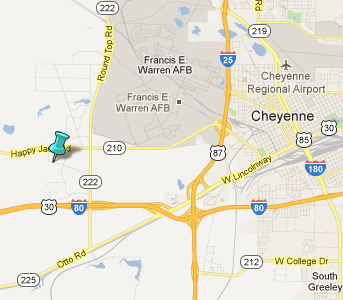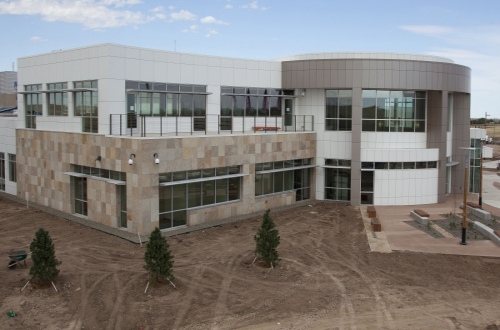A public-private success story
Interview | A look at the coalition behind the NCAR-Wyoming Supercomputing Center
Sep 17, 2012 - by Staff
Sep 17, 2012 - by Staff
September 17, 2012 | A great deal of work had already taken place before workers turned over the first mound of soil on the prairie that now houses the NWSC. The public-private partnership that led to the NWSC’s creation emerged through a fortuitous mix of geographical, technological, institutional, and human variables, plus the ability to recognize opportunity and act on it. We asked two of the principals involved to share the story as they saw it first hand: Randy Bruns, head of the nonprofit economic development group Cheyenne LEADS, and Jeff Reaves, associate UCAR vice president for business services. A roster of contributing partners is here.
|
Jeff Reaves |
Randy Bruns |
Reaves: We looked at a number of options for meeting our need for a new data center: expanding on the NCAR mesa, leasing or remodeling an existing data center, retrofitting some other building. Then we decided to look at co-hosting it with a university along the Front Range, somewhere between Golden and Fort Collins, where there would be adequate transmission-level power, high-speed bandwidth fiber, and room for future growth. We were pretty far down the road in selecting a Front Range site when we got the call from Randy asking if we would entertain a proposal from Cheyenne.
Bruns: We’d been trying to recruit companies involved in computer-centric technology. Our university and our community colleges are turning out tech-capable people, but for the most part, they leave the state for jobs. We don’t have a huge workforce in Wyoming. But we do have abundant power. And here in Cheyenne, we’re sitting on a lot of fiber that runs coast to coast but is largely untapped. Cheyenne exists because of the transcontinental railroad, and we also became an interstate corridor. And both rail and highway corridors tend to serve as corridors for data.

The NWSC (turquoise pin) is located several miles west-northwest of downtown Cheyenne. (Map © 2012 Google.)
Reaves: There were several proposed sites in Wyoming. The ones in Cheyenne had access to transmission-level power, which was important for us. The site we ended up choosing was about double the size of our minimum requirement for land, which offered a number of advantages in terms of mechanical and electrical infrastructure and potential expansion. Also, they were willing to deed the land [24 acres] to us, whereas some of the universities wanted to retain ownership, even with a no-cost lease. Then there were financial incentives: the land at no cost, plus infrastructure to the site. The state legislature offered $20 million in cash toward construction of the facility, and the university offered $1 million per year for the next 20 years for the ongoing operation of the facility. Cheyenne Light, Fuel & Power agreed to provide both primary and secondary power at no extra cost, so that if one substation goes down, they can switch us to another. They were also willing to provide 10% of our power needs with renewable energy from the nearby Happy Jack wind farm.
Also, NSF encouraged us to consider Wyoming because it was an EPSCoR state. So there was this added benefit, which opened up opportunities to serve a broader community. [EPSCoR, the Experimental Program to Stimulate Competitive Research, helps direct funding to 31 U.S. states and territories that receive a disproportionately small fraction of NSF research funding.]
Bruns: We involved the Wyoming Business Council [the state’s economic development arm], the governor’s office, and the University of Wyoming, all at the highest levels. The fortunate thing is that, in a state this size, we all know one another—the academic world, the private sector, and the government side, both state and local—so it’s fairly easy to reach across organizational boundaries. Essentially the entire legislature understood the significance of this. In a matter of hours and days, they were all on board.
It wasn’t the largest construction project by any means that we’ve attracted here. It certainly wasn’t the largest employer. And yet in a very subtle but profound way, everybody recognized the potential and the power of this relationship.

Seven major University of Wyoming projects on the NWSC's Yellowstone supercomputer will address topics ranging from hydrology of the Colorado River Basin to planet formation from star debris to fluid dynamics of wind turbines.
In addition, through EPSCoR (see above), the university recently received its largest-ever research grant, a $20 million, five-year award for a variety of water-related studies involving four UW colleges and 11 departments.
“UW’s computational researchers are working on projects that are of great importance to Wyoming, the U.S. and, in fact, the entire world,” says Bryan Shader, UW’s special assistant to the vice president of research and economic development. “All of this research is big science.”
Bruns: With the prospect of this center being here, the university immediately began to make changes, with undergraduate and graduate offerings, and began expanding the relationship with NCAR in terms of personnel and shared staff. It also helped certify the case that Cheyenne in particular, and Wyoming in general, had substantial capabilities in the tech sector. It highlighted those not only for outsiders but in some respects even for people right here in Wyoming.
Echostar Communications has expanded—they’re now up to more than 400 employees, all tech workers. Then in April 2012, Microsoft announced that they’re putting a huge data center complex here in Cheyenne. So the momentum is building.
Reaves: We recognized that technology had evolved to the point where you really didn’t have to have the machines collocated with the scientists. We’d already been serving the university community all over the world. Then it was a matter of how far away we could go from Boulder, which depended on broadband accessibility.
One of the things that made Cheyenne doable was that BiSON already existed. [BiSON, the Bi-State Optical Network, connects the University of Wyoming to the Denver-based Front Range GigaPop, which in turn links research and higher education institutions across northern Colorado, including NCAR.]
Bruns: One of the things we’ve learned is that there’s a lot of commercial fiber here. We believe we’re in an excellent position for Microsoft and companies like them. We’re also very confident of our long-range ability to provide power to these centers. And NCAR has been willing to share much of what they learned with us, so we can talk with some authority about the unique advantages that our high, dry, cool environment provides for efficient operation of data centers.
I think the real power of this center being here is an expansion of the Colorado technology corridor into Wyoming in a very tangible way. We’ve also opened the doors for expanded science at the University of Wyoming and elsewhere. At the end of the day, it’s about creating the capability to do better science, more science, faster science, in an area that’s critically important to the United States and arguably the world: understanding the environment that we live in.
Reaves: It’s crucial to know what your needs and requirements are and whether or not you can really satisfy them. You might be willing to make some tradeoffs, but at least you know the impacts of those tradeoffs. We knew what our then-current computing capacity was and where we needed to go in the next 10 to 20 years. We had a pretty good idea of what was required in terms of power, cooling, and computing to meet that demand. So our specs and requirements were very clearly spelled out.
Another extremely important aspect is the partners themselves. I can’t emphasize enough what a great partnership we’ve developed with people in Wyoming—the legislature, the business community, the academic community. We listened and did what we could to meet their needs while satisfying our own. We developed a true partnership, up and down the line.
Bruns: First of all, you have to get the right people and the right organizations to the table. In our case, there were key people at very significant points who grasped a vision for this project. [Former NCAR director] Tim Killeen was extraordinarily open to shifting directions at a time when NCAR’s selection process was starting to narrow. Governor [Dave] Freudenthal grasped the potential for this to expand the university, expand Wyoming’s presence in the tech sector, and tie our state even more solidly to science and research. The university president, Tom Buchanan, very quickly saw the big-picture, long-term implications of this center as the basis for an expanding relationship and for making significant positive changes at his institution. So there were a handful of people who intuitively understood the potential of this and committed their organizations to exploring how to make it happen. I think having people of vision like that was an amazing alignment of stars.

This photo of the NWSC, looking northeast, was taken during final stages of building construction. It shows meeting areas (left) and the entrance foyer (right). (©UCAR. Photos by Carlye Calvin.)